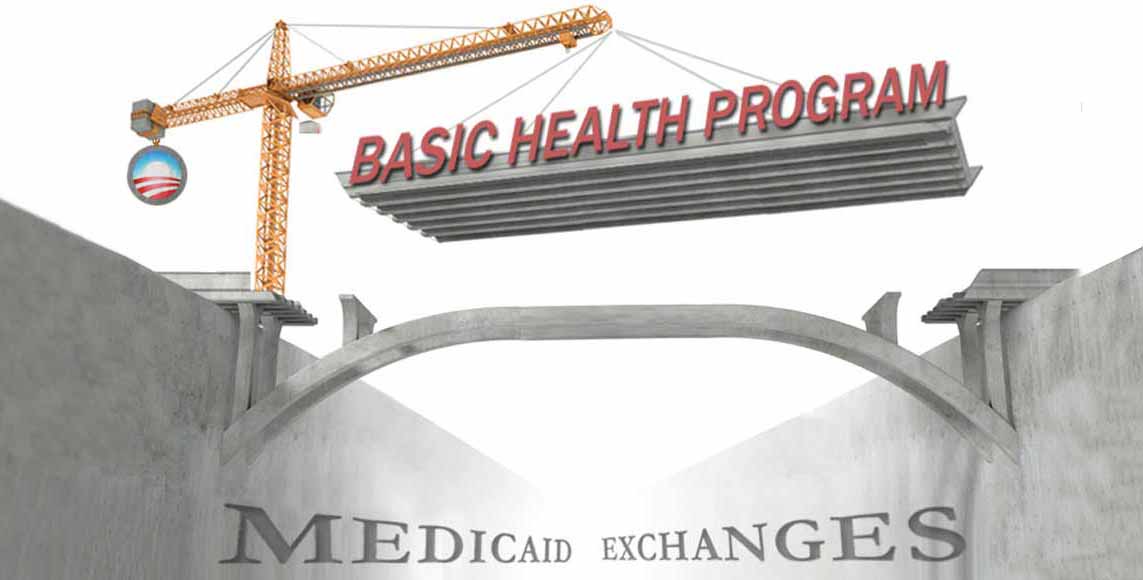
In this article
What is the Basic Health Program?
The Basic Health Program (BHP) – section 1331 of the ACA – allows states to create a coverage program for adults with household income between 138% and 200% of the federal poverty level (FPL).1 Like Medicaid, enrollment in a BHP is available year-round for eligible applicants.
The ACA's Medicaid expansion, which most states have implemented, covers adults with household income up to 138% of FPL. In states that implement a BHP, eligibility picks up where Medicaid expansion ends, and extends to 200% of FPL. States can fund a BHP using federal funding that would otherwise have been spent on Marketplace premium subsidies for those enrollees. The federal government will give the state 95% of the amount the federal government would otherwise have spent on subsidies, and the state can supplement that funding with additional state funding.2
But as explained below, most states have not established a BHP. A 2024 Urban Institute assessment concluded that implementation of a BHP by five additional states could make coverage more affordable while fully covering state costs with federal payments.3
Which states have Basic Health Programs?
As of mid-2026, three states and the District of Columbia are expected to have Basic Health Programs:
- Minnesota (MinnesotaCare) — already in effect
- Oregon (OHP Bridge) — already in effect
- District of Columbia (Healthy DC Plan) — expected to begin Jan. 1, 2026, with enrollment beginning Nov. 1, 2025, pending federal approval4
- New York (the Essential Plan) — already in effect, but technically not a BHP from April 2024 through June 2026.
New York's Essential Plan was previously a Basic Health Program, but its authority switched from ACA Section 1331 (BHP) to Section 1332 (innovation waiver) in 2024.5 At that point, Essential Plan eligibility was extended to 250% FPL.
However, New York has announced that due to federal funding cuts, the state plans to revert to a BHP starting in July 2026. At that point, the Essential Plan will return to its original 200% FPL income limit.6
How long have states operated Basic Health Programs?
The ACA's Basic Health Program was originally scheduled to begin January 1, 2014, but was postponed until 2015. To date, three states have implemented a BHP: Minnesota's BHP was effective in January 2015 (see Minnesota's BHP blueprint), New York's took effect in January 2016 (see New York’s BHP blueprint), and Oregon's took effect in July 2024 (see Oregon's BHP blueprint). DC is working to create a BHP that will take effect in January 2026, with enrollment beginning November 1, 2026.7
New York received federal permission in 2024 to switch its BHP to a section 1332 innovation waiver program, with eligibility expanded to cover people up to 250% of the FPL. That change took effect on April 1, 2024.8 But as noted above, New York has begun the process of reverting back to a BHP, and hopes to have that change in place by July 2026.6
Current BHP coverage details
Here's an overview of how BHP coverage works (or will work) in Minnesota, Oregon, New York, and the District of Columbia:
MinnesotaCare: Minnesota has operated MinnesotaCare since 1992,9 but the program transitioned to a BHP in 2015. As of 2024, about 98,000 people were enrolled in MinnesotaCare.10
- Cost-sharing: Some enrollees, including children, pregnant women, and Native Americans, don't pay any cost-sharing. For other adults, there is modest cost-sharing for various services.11
- Premium: In 2025, MinnesotaCare has no premium if the enrollee's household income is less than 169% of FPL. Between 160% and 200% of FPL, monthly premiums range from $4 to $28.12 These premiums will increase in 2026 if the American Rescue Plan's subsidy enhancements are allowed to expire.
- Eligibility: Coverage is available to adults who aren't eligible for Medicaid (Medical Assistance) and whose household income isn't more than 200% of FPL.
Oregon's OHP Bridge: The OHP Bridge program became available starting in July 2024. More than 32,000 people were enrolled in OHP Bridge as of early 2025.13
- Cost-sharing: OHP Bridge does not have any cost-sharing.14
- Premiums: OHP Bridge does not have any premiums.14
- Eligibility: Coverage is available to adults who aren't eligible for Medicaid, and whose household income isn't more than 200% of FPL.
New York's Essential Plan: New York's Essential Plan covers nearly 1.7 million people as of August 2025.15
- Cost-sharing: Enrollees with household income up to 150% FPL have no out-of-pocket costs. Enrollees above that level pay modest cost-sharing for some services.16
- Premiums: There are no premiums for the Essential Plan as of 2025.16
- Eligibility: Currently available to adults with household income above 138% of the FPL, but not more than 250% of FPL. Starting in July 2026, New York plans to reduce the eligibility limit to 200% of FPL.17
Healthy DC Plan: Washington, DC is preparing to launch the Healthy DC Plan in the fall of 2025, with coverage effective in January 2026.18 The District's BHP blueprint approval was approved by CMS in October 2025.19
- Cost-sharing: There will be no out-of-pocket costs for covered services.18
- Premiums: There will be no premiums for Healthy DC Plan coverage.18
- Eligibility: Will be available to adults with household income above 138% FPL, up to 200% FPL. For coverage to start January 1, 2026, applicants must enroll by December 15, 202518
Since 2010, DC has provided Medicaid to residents with household income up to 215% FPL.20 But that will end on Dec. 31, 2025, and Medicaid eligibility in DC will drop to 138% FPL starting in January 202621 (that's the normal Medicaid expansion eligibility limit that's used in the 40 states that have expanded Medicaid under the ACA). DC is working to make the transition to the Healthy DC Plan as seamless as possible for people with household income between 139% and 200% FPL.22
Louise Norris is an individual health insurance broker who has been writing about health insurance and health reform since 2006. She has written hundreds of opinions and educational pieces about the Affordable Care Act for healthinsurance.org.
Footnotes
- "Basic Health Program. The Affordable Care Act offers states another option besides Medicaid and the exchanges for health coverage for low-income residents" Health Affairs. Nov. 15, 2012 ⤶
- "Basic Health Program" Centers for Medicare & Medicaid Services. Accessed Sep. 12, 2025 ⤶
- “Implementing a Basic Health Program” Urban Institute. January 2024 ⤶
- "Community Leadership Meeting" Healthy DC Plan. Sep. 16, 2025 ⤶
- "New York’s Basic Health Program Suspension Approval Letter" Centers for Medicare & Medicaid Services. Mar. 1, 2024 ⤶
- "Following Devastating Federal Funding Cuts, New York State Takes New Action to Preserve Health Care for As Many New Yorkers As Possible" New York Department of Health. Sep. 10, 2025 ⤶ ⤶
- "Basic Health Plan" DC Health Benefit Exchange Authority. Accessed Oct. 9, 2025 ⤶
- “Governor Hochul Announces Federal Approval to Expand Access to High-Quality, Affordable Health Insurance" New York State Governor Kathy Hochul. March 4, 2024. ⤶
- “MinnesotaCare Basics; History” Minnesota Department of Human Services. Accessed June 17, 2024 ⤶
- "Who Medicaid and MinnesotaCare serve" Minnesota Department of Human Services. Accessed Sep. 12, 2025 ⤶
- "2025 Managed Care Summary of Coverage, Cost Sharing and Limits for MinnesotaCare" Minnesota Department of Human Services. Accessed Sep. 12, 2025 ⤶
- "MinnesotaCare Premium Estimator Table, Effective January 1, 2025 – December 31, 2025" Minnesota Department of Human Services. Accessed Sep. 12, 2025 ⤶
- "OregonHealthCare.gov connected nearly 140,000 people to coverage in 2025, strengthening health equity statewide" Oregon Health Authority. Jan. 30, 2025 ⤶
- “Oregon Health Plan (OHP) Bridge – Frequently Asked Questions” Oregon Health Authority. May 3, 2024 ⤶ ⤶
- "EP and QHP Enrollment as August 30, 2025" New York State of Health. Aug. 30, 2025 ⤶
- "Essential Plan Information" New York State of Health. Accessed Sep. 12, 2025 ⤶ ⤶
- "Following Devastating Federal Funding Cuts, New York State Takes New Action to Preserve Health Care for As Many New Yorkers As Possible" New York State Department of Health. Sep. 10, 2025 ⤶
- "NEW Healthy DC Plan" DC Health Link. Accessed Oct. 9, 2025 ⤶ ⤶ ⤶ ⤶
- "BHP Advisory Council Meeting #15" DC BHP Advisory Council. Oct. 20, 2025 ⤶
- "A Quasi-Experimental Study of Medicaid Expansion and Urban Mortality in the American Northeast" PubMed Central. Nov. 17, 2021 ⤶
- "Adults Without Dependent Children (Childless Adults)" DC Department of Health Care Finance. Accessed Oct. 9, 2025 ⤶
- "Healthy DC Plan for District Residents Losing Medicaid Coverage" DC Health Link. Accessed Oct. 20, 2025 ⤶


